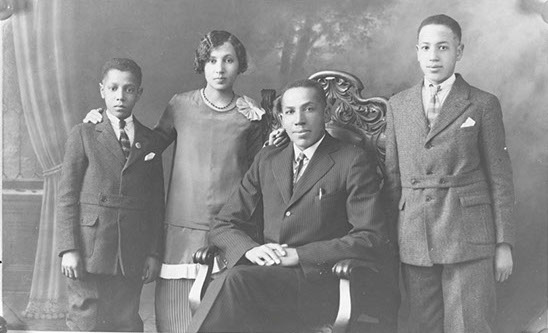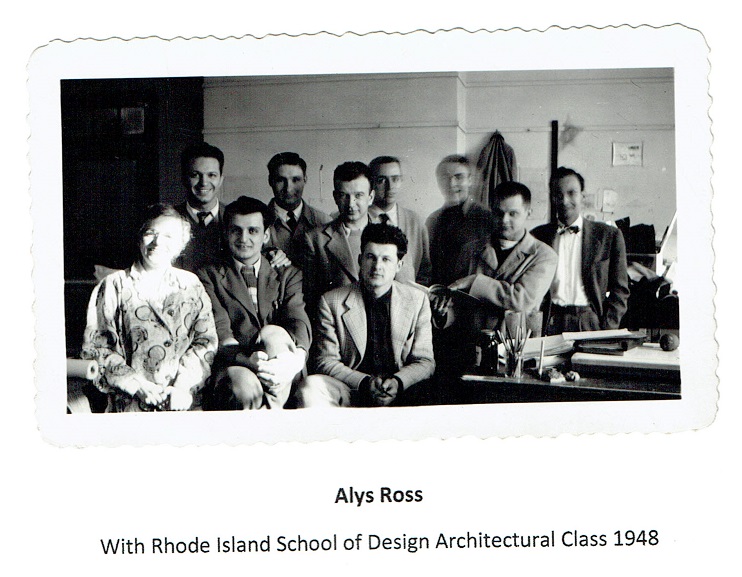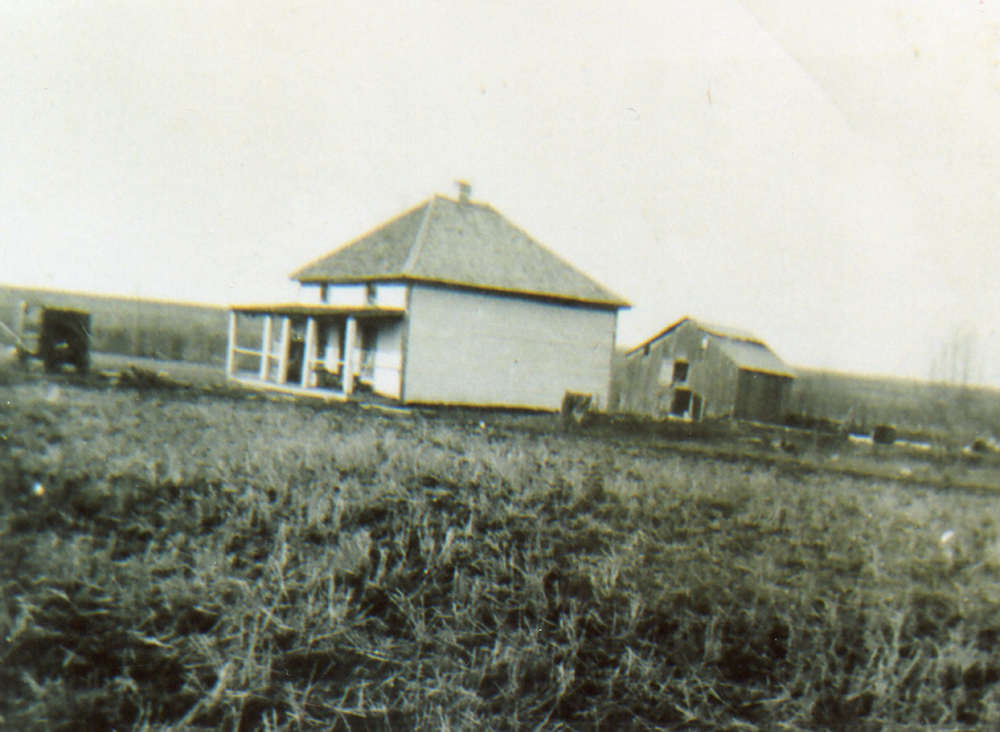Many Black immigrants who came to Alberta as family groups in the early 1900s had previously lived in Oklahoma Territory alongside the Five Civilized Tribes (the Cherokee, Creek, Seminole, Chickasaw, and Choctaw nations). Following the creation of the state in 1907, Black residents faced increased levels of discrimination through segregation laws and voter disenfranchisement.

Around that same time, advertisements promoting farms of 160 acres for $10 in Western Canada appeared in American newspapers. As racism in the United States increased along with mob lynching of Black people and the burning of Black towns and businesses, folks began looking for options to escape racism and disenfranchisement.
An advertisement from the Boley Progress newspaper, 11 February 1911.
Black immigrants who came to Alberta in the early 1900s settled primarily in four isolated rural communities: Junkins (now known as Wildwood), Keystone (now Breton), Campsie (near Barrhead), and Pine Creek (later renamed Amber Valley). All four of these communities are mentioned in the Our Negro Citizens column published in the Edmonton Journal and Edmonton Bulletin in the early 1920s.
Although Amber Valley was the largest and most well-known, Junkins was the first community with a significant number of Black pioneers. Junkins, Breton, and Campsie had increasing numbers of Europeans join the communities.
Deborah Beaver
Watch
A short interview with Deborah Beaver about her connections to the Black settlements of Alberta & Saskatchewan and her family connections to Campsie, Alberta. Recorded on 27 July 2021. Interview conducted by Christina Hardie as part of the And Still We Rise: A Black Presence in Alberta virtual exhibit hosted by the Edmonton City as Museum Project, based on research by Dr. Jennifer Kelly.

According to the 1911 census, only 30% of early Black arrivals were located in urban areas with 72 people in Calgary and 208 in Edmonton.
In 1921, the census recorded 66 individuals under the “Negro” column in Calgary, while Edmonton’s Black population had grown to 277 people. The census also revealed that 74% of American-born Black people in Alberta had become naturalized (gained citizenship).
Junkins
The first recorded group of Black folks stepped off the train at Edmonton in April 1908 and consisted of seven families who intended to settle in the area of Junkins (now known as Wildwood), west of Edmonton.


With settlement came the building of homes, churches, post offices, and schools. Breton organized Good Hope Baptist Church and Funnell School. Junkins organized Grace A.M.E. Church and Empyreum School.
“The colored citizens of Junkins, as well as the whites are enterprising. There are four saw –mills there, one of which is owned by a colored company that is just finishing off a contract of nearly $300,000 feet of lumber and the quality of work of this company has tested second to none. They are averaging 50,000 feet every five days.”
Edmonton Bulletin, February 1922.
Toles School at Amber Valley: Mr. George Cromwell & Mrs. Alice Cromwell
Mr. George Cromwell & Mrs. Alice Cromwell were college-educated Black teachers from Ontario who taught full time at the Toles School in Amber Valley from 1918/19 until the late 1940s/ early 1950s. In the 1930s, Mrs. Cromwell selected the name Amber Valley to replace the district name of Pine Creek.
Toles School at Amber Valley: Mr. George Cromwell & Mrs. Alice Cromwell
Mr. George Cromwell & Mrs. Alice Cromwell were college-educated Black teachers from Ontario who taught full time at the Toles School in Amber Valley from 1918/19 until the late 1940s/ early 1950s. In the 1930s, Mrs. Cromwell claimed the name Amber Valley to replace the district name of Pine Creek.

“Well, we had to have a name for it. What is the best name for it? This was a beautiful time of the year that we were talking about this. The grain was golden, and the leaves falling off the trees were very pretty. So, I thought that would be appropriate name for Amber Valley— amber in colour. Out of the names put forth, they chose mine.”
During the Cromwells’ time at the school, the number of pupils increased more than in other rural schools. Alice Cromwell recalls her first encounter with people in Amber Valley:
“I remember when we first went out there they had mules. 1919, it was right after the First WorldWar, the end of it. We had come to Edmonton and they were clamouring for some teachers, all of the western provinces were because they had difficulty in getting Ontario teachers and that’s where we both graduated. My husband was three years older than I and he attended the same school or university.”
The Alberta Labour History Institute (ALHI) interviewed Gwen Hooks, an important figure in Breton. She “became a teacher, and then principal of a special education school; president of a local Alberta Teachers’ Association chapter; opened a museum in Breton.” You can watch the full interview below.
Gwen Hooks being interviewed by Dr. Jennifer Kelly, May 2001
Watch
Gwendolyn Hooks was born in Keystone (now Breton) to an Oklahoman father and a Kansan mother. Her parents arrived as one of 52 farming families escaping Jim Crow laws and lynching in the southern United States. Gwen’s mother-in-law was Creek. After attending schools from elementary to college in various Alberta rural districts, Gwen Hooks began her teaching career in the early 1940s.
The following image gallery and newspaper clippings provide a window into the lives of residents of Breton, Keystone, and Amber Valley during this time period.





Guiding questions
- Who would be writing these headlines?
- What words might be clues to their opinions?
- As an African-American immigrating to Canada at this time, how would you feel reading these headlines?
Oral History: Mrs. John King reflects on crossing the border into Canada and her journey to the Edmonton area
“… it was in April 1911. Thirty-five families. We came across at Emerson [in southern Manitoba].
When we came to Edmonton, we all lived on 8th Street and all lived in tents. Eight families and we lived there until we all got settled. We started in April, come and spied on the land, and then we lived in Edmonton in the winter and then came back to Keystone they called it then.
We had some neighbours that we knew, and they had lived here [Alberta] three years and they helped us find the land and we knew them, and their names was Allens and they invited us to come.”
Q: Why such an isolated area?
Because … we had some neighbours from where we lived, and they had been living here we thought we would come on out here and file. The Kings, the Allens, and Hayes… They came from Oklahoma the same town.
Sneed [brothers] Allens, they went to different places. Some went to Wildwood some went to Athabasca. All of them that I knew came from Oklahoma but not in the same town.
Q: What were their occupations in the US?
Most were farmers.
….
Q: What problems did you encounter?
It was cold. First winter we kind of shivered a little. We soon go to it we had plenty clothes but we didn’t know it was as cold as it was.

Farming was an important occupation for Black pioneers living in the four main rural communities in Alberta (Junkins, Keystone, Pine Creek & Campsie). In winter, many left their homesteads to work on construction or in meatpacking to supplement their income.
Pictured: Sylvester Hinton and half-sister Louis Hamilton on Howard Hamilton’s tractor. No date. Athabasca Archives, 14375.

Quote from Judith Hill researcher sharing the story of immigration from Oklahoma to Pine Creek/Amber Valley, 1981
“The sequence of events which preceded the first large migration of Oklahoma Blacks into Pine Creek area (renamed Amber Valley in the early 1930s by a schoolteacher) is fairly well-documented.
Sometime during January or February of 1910, the first party left Oklahoma. They were a small all-male group led by two middle-aged men, Jordan Murphy of Chandler City and Nim Toles of Clearview. Their initial destination was Kansas City where they made arrangements for immigration through J.S. Crawford, the Canadian Government agent.
From Kansas they travelled by train, crossing the border at Emerson, Manitoba and proceeding directly to Edmonton. It seems likely that this group was sent to reconnoiter [research]. They must have been pleased with what they saw for they filed on thirteen homesteads in the Amber Valley area that Spring and sent enthusiastic reports home to Oklahoma, urging their friends and relatives to join them.”

Guiding questions
- As an African-American immigrating to Canada at this time, how would you be feeling? Excited? Nervous? Hopeful?











